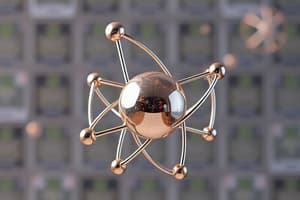Podcast
Questions and Answers
What is the function of the atomic number in an atom?
What is the function of the atomic number in an atom?
- Defines the element (correct)
- Indicates the energy level
- Defines the isotope
- Determines the atomic mass
Which of the following is an arrangement of electrons in an atom's energy levels?
Which of the following is an arrangement of electrons in an atom's energy levels?
- Electron configuration (correct)
- Electron shell
- Electron spin
- Electron cloud
What is the periodic trend for atomic radius?
What is the periodic trend for atomic radius?
- Decreases from left to right and increases down a group (correct)
- Remains constant across a period
- Increases from left to right and decreases down a group
- Increases down a group and remains constant across a period
What is the purpose of the Aufbau principle in electron configuration?
What is the purpose of the Aufbau principle in electron configuration?
What is the function of neutrons in an atom?
What is the function of neutrons in an atom?
What is the purpose of the periodic table?
What is the purpose of the periodic table?
What is the definition of a chemical reaction?
What is the definition of a chemical reaction?
Which type of chemical reaction involves the combination of two or more substances to form a new substance?
Which type of chemical reaction involves the combination of two or more substances to form a new substance?
What is the purpose of a chemical equation?
What is the purpose of a chemical equation?
What type of chemical bond involves the transfer of electrons between atoms?
What type of chemical bond involves the transfer of electrons between atoms?
What is the main purpose of the valence shell electron pair repulsion (VSEPR) theory?
What is the main purpose of the valence shell electron pair repulsion (VSEPR) theory?
Flashcards are hidden until you start studying
Study Notes
Atomic Structure
- An atom consists of:
- Protons (positively charged) in the nucleus
- Neutrons (no charge) in the nucleus
- Electrons (negatively charged) in energy levels around the nucleus
- Atomic number: number of protons in an atom (defines the element)
- Mass number: number of protons and neutrons in an atom (defines the isotope)
- Atomic mass: average mass of an element's naturally occurring isotopes
Periodic Table
- Organizes elements by their atomic number and chemical properties
- Elements are arranged in:
- Periods (rows): elements with similar energy levels
- Groups (columns): elements with similar chemical properties
- Periodic trends:
- Atomic radius: decreases from left to right and increases down a group
- Electronegativity: increases from left to right and decreases down a group
Electron Configuration
- The arrangement of electrons in an atom's energy levels
- Energy levels (shells): 1, 2, 3, ... (each with a specific capacity)
- Subshells: s, p, d, f (each with a specific capacity)
- Aufbau principle: electrons occupy the lowest available energy level
- Hund's rule: electrons occupy degenerate orbitals with parallel spin
- Electron configuration notation: 1s2 2s2 2p6, ...
Chemical Reactions
- A process involving the transformation of one or more substances
- Types of chemical reactions:
- Synthesis: two or more substances combine to form a new substance
- Decomposition: a single substance breaks down into two or more substances
- Single displacement: one element replaces another in a compound
- Combustion: a substance reacts with oxygen to produce heat and light
- Chemical equations: a representation of a chemical reaction using chemical formulas and arrows
Chemical Bonding
- The attractive forces between atoms that hold them together
- Types of chemical bonds:
- Ionic bond: transfer of electrons between atoms (e.g., NaCl)
- Covalent bond: sharing of electrons between atoms (e.g., H2)
- Polar covalent bond: unequal sharing of electrons between atoms (e.g., HCl)
- Bonding theories:
- Valence shell electron pair repulsion (VSEPR) theory: predicts molecular shape
- Molecular orbital (MO) theory: predicts molecular structure and bonding
Atomic Structure
- An atom consists of protons, neutrons, and electrons, with protons and neutrons in the nucleus and electrons in energy levels around the nucleus.
- The atomic number, which defines the element, is the number of protons in an atom.
- The mass number, which defines the isotope, is the sum of protons and neutrons in an atom.
- Atomic mass is the average mass of an element's naturally occurring isotopes.
Periodic Table
- The periodic table organizes elements by their atomic number and chemical properties.
- Elements are arranged in periods (rows) and groups (columns), with similar energy levels in periods and similar chemical properties in groups.
- Atomic radius decreases from left to right and increases down a group, while electronegativity increases from left to right and decreases down a group.
Electron Configuration
- Electron configuration is the arrangement of electrons in an atom's energy levels, with each energy level (shell) having a specific capacity.
- Subshells, including s, p, d, and f, also have specific capacities.
- The Aufbau principle states that electrons occupy the lowest available energy level, while Hund's rule states that electrons occupy degenerate orbitals with parallel spin.
- Electron configuration notation is written in the format 1s2 2s2 2p6, etc.
Chemical Reactions
- Chemical reactions involve the transformation of one or more substances, with types including synthesis, decomposition, single displacement, and combustion reactions.
- Chemical equations represent chemical reactions using chemical formulas and arrows.
Chemical Bonding
- Chemical bonds are the attractive forces between atoms that hold them together, with types including ionic, covalent, and polar covalent bonds.
- Ionic bonds involve the transfer of electrons between atoms, while covalent bonds involve the sharing of electrons.
- Polar covalent bonds involve the unequal sharing of electrons between atoms.
- Bonding theories, including VSEPR and MO theories, predict molecular shape and structure.
Studying That Suits You
Use AI to generate personalized quizzes and flashcards to suit your learning preferences.




